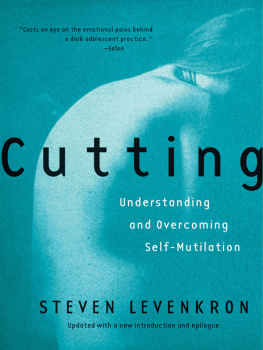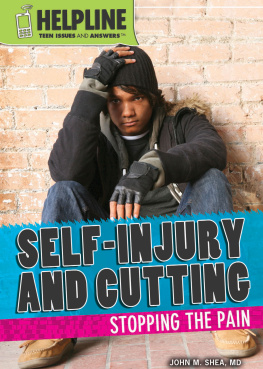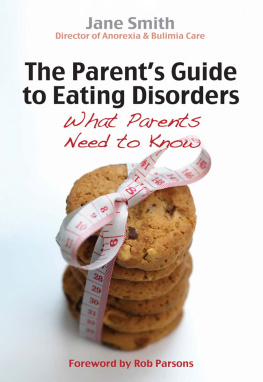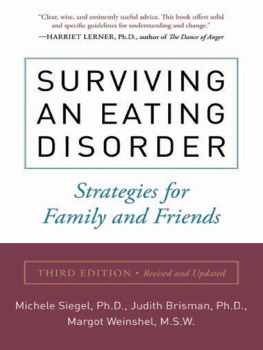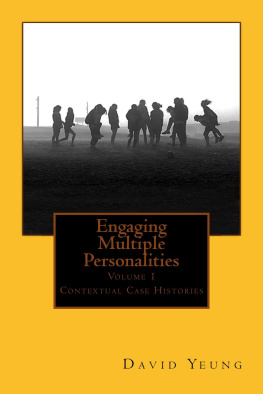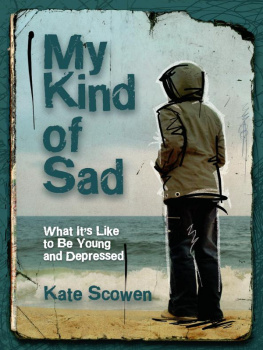
OTHER BOOKS BY STEVEN LEVENKRON:
The Best Little Girl in theWorld
Treating and Overcoming Anorexia Nervosa
Kessa
Obsessive-Compulsive Disorders
The Luckiest Girl in theWorld
Anatomy of Anorexia

For my wife and lifetime partner in all things, including this work, Abby Levenkron
Copyright 1998, 2006 by Lions Crown, Ltd.
All rights reserved
Printed in the United States
First published as a Norton paperback 1999
For information about permission to reproduce selections from this book,
write to Permissions, W. W. Norton & Company, Inc., 500 Fifth Avenue, New York, NY 10110.
Book design by JAM Design
Library of Congress Cataloging-in-Publication Data
Levenkron, Steven, 1941
Cutting : understanding and overcoming self-mutilation / Steven Levenkron.
p. cm.
Includes bibliographical references and index.
ISBN 0-393-02741-4
ISBN 978-0-393-24461-8 (e-book)
1. Self-mutilationPopular works. I. Title.
RC552.S4L48 1998
616.85'82dc21 9810274
CIP
ISBN-13: 978-0-393-31938-5
ISBN-10: 0-393-31938-5 pbk.
W. W. Norton & Company, Inc.
500 Fifith Avenue, New York, N.Y. 10110
www.wwnorton.com
W. W. Norton & Company Ltd.
Castle House, 75/76 Wells Street, London WCT 3QT
CONTENTS
W hen I began to write the original edition of Cutting, I had no idea that the prevalence of self-mutilation, according to most estimates today, would be one out of fifty adolescents. At the time, a survey done by the Canadian Broadcasting Company in 1999 suggested one out of one hundred and fifty adolescents was a self-injurer. Currently, while lecturing in areas throughout New England and the Mid-Atlantic states, the feedback from school counselors and faculty as well as community mental health professionals indicates a remarkably higher prevalence.
That such a high rate of young people feel compelled to assault their skin to relieve negative feelings indicates to us how many suffer from emotional pain and have inadequate verbal skills to work through this pain with thought and talk. It also speaks to the issues of bonding, trust, and intimacy, all of which would create emotional safety in relationships. The language for these issues is learned from others or it doesnt develop at all, leaving the person to resort to a solutionthat requires no language and is applied in isolation.
Cutting addresses this prevalent problem, and since its initial publication it has been translated into languages representing such diverse cultures as Japanese, German, and Chinese. The books reception suggests that this disordered behavior is cross-cultural. The behavior is also seen across class lines, income levels, and all habitation settings, from urban to rural. It seems that under a given set of circumstances, self-injury represents an aspect of human nature.
This set of circumstances encompasses a spectrum of backgrounds ranging from seemingly benign life experiences, such as insufficient verbal communication between parents and children, to malevolent, cruel, and sexually assaultive experiences causing trauma. These experiences typically include an additional trauma to the victim: the perpetrator forbids communication about these assaults and/or rapes. He often threatens injury or death to the victim or her loved ones if she tells of the abuse.
In the pages that follow, we will see examples of all of the above in the form of anecdotes drawn from therapy sessions. The reasons for these anecdotes are twofold: first to illustrate the range of the spectrum of cases and backgrounds, allowing the reader to find elements of his/her experiences; and second, to demystify behavior that is viewed by many, including professionals, to be madness. Cutting interprets this behavior and its development as an adaptive coping mechanism arising out of desperation.
In order to eradicate these behaviors, societies throughout the world will have to focus on child raising, better protection of children, and practices that promote healthy parental role-modeling. Permission for these kinds of exchanges between members of the family will have to be present both implicitly and explicitly in the family environment. Without the presence of these elements, children are left to their own meager resources to invent solutions to reduce their emotional pain. These behavioral disorders are not limited to self-injury but include obsessive-compulsive disorders, anorexia nervosa, bulimia nervosa, and substance abuse.
New York
January 2006
A s a modern society, we have become inured to watching open-heart surgery and emergency-room procedures on television. With the help of our own experiences and the information provided by modern media, we now casually discuss gynecological problems, childbirth, cancer, organ transplants, and so on.
Yet we still shrink from acknowledging the signs of emotional and mental pain. This book takes a look at the difficult subject of self-mutilation: how it relates to our society, and our fear of the dark impulses that lurk within us all.
Until 1996, the public had little familiarity with self-mutilation. Then Princess Diana volunteered that she had been a cutter, and articles on the topic began to appear in popular magazines.
Often I meet new patients who say that they already have tried several therapists before coming to me. As soon as they indicate that they are self-mutilators, the therapists respond that they have no experience and decline to treat them. Why hasnt this disorder been looked at more carefully in the past? Perhaps because such pathological behavior is as repellent to the psychological community as it is to the general public.
Back in 1974, when I first treated anorexics, my colleagues, most of them psychiatrists, tried to dissuade me. Steve, they would say, specializing in treating anorexics would be like having an entire practice of suicidal patients. Coping with anorexics was considered foolish and frightening at a time when a therapist could seek out a patient population who simply wanted to be analyzedto lie on a couch and free-associate about their childhoods. Over the past twenty-four years, an entire subdivision of the profession has sprung up to research and treat eating disorders.
Yet, aside from the current publicity, most of which is sensational, unhealthily explicit, and serves only to frighten and disgust people, we are still largely in the dark about the phenomenon of self-mutilation. Much research remains to be done. Our primary source of information will be those people who have engaged in this behavior in the past and those that are doing it in the present: the patients themselves.
The mental health profession (whether its members have medical or nonmedical backgrounds) will have to get comfortable talking with patients, in detail, about cutting and burning oneself. They will have to get used to demanding that their patients show them the damage done, inspect this damage, and determine whether or not a physician needs to treat them. All of this must become a natural and comfortable part of the therapists treatment repertoire. It requires, in most cases, knowledge equivalent to the medical information found in the Boy Scout Manual.
When therapists first began to treat eating disorders, they had to learn about electrolytic imbalance, heart rate, blood pressure, body temperature, blood values, and organ function, as well as estrogen levels and their relationship to menstruation, and weight-to-height ratios. Suddenly, therapists were talking with their patients about intimate details of bodily function. This was something that had rarely occurred in previous therapies. These are patients who are mystified by their bodies and who deliberately distort their physical appearance. They need therapists who, as their teachers, will feel as comfortable and knowledgeable about their patients bodies as their minds.
Next page
